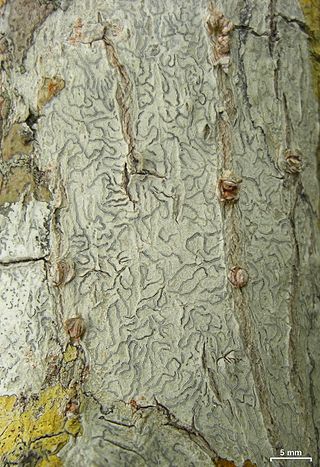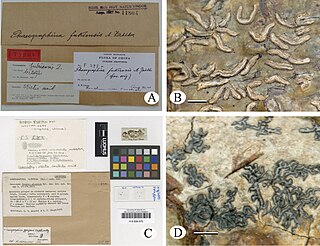
Platygramme is a genus of lichen-forming fungi in the family Graphidaceae consisting of about 30 species. The genus was circumscribed by Antoine Laurent Apollinaire Fée in 1874.

Graphis is a genus of lichen-forming fungi in the family Graphidaceae.

Fissurina is a genus of lichenized fungi in the family Graphidaceae. It has about 160 species, most of which are found in tropical regions.
Diorygma microsporum is a species of corticolous (bark-dwelling) crustose lichen in the family Graphidaceae. It was described as new to science in 2011. It has a neotropical distribution, and has been collected in Florida, Colombia, Brazil, and India. Notable for its small ascospores, this lichen thrives in undisturbed rainforests and serves as an indicator of forest health.
Anomomorpha tuberculata is a species of corticolous (bark-dwelling) crustose lichen in the family Graphidaceae. Found in rare cerrado vegetation in southern Costa Rica, it was described as new to science in 2011. It is characterised by its conspicuous tubercles on the thallus and sessile lirellae.

Graphis plumierae is a species of script lichen in the family Graphidaceae. It was described as new to science in 1915 by Finnish mycologist Edvard Vainio. The type was collected in Gourbeyre, Guadeloupe. In 2016, G. plumierae was reported from Portugal, which was also a new occurrence for Europe.

Coenogonium is a genus of crustose lichens in the monotypic family Coenogoniaceae. It has about 90 species. Most species are leaf-dwelling or grow on bark, although a few are known to grow on rocks under certain conditions, and some are restricted to growth on termite nests. The genus was circumscribed in 1820 by German naturalist Christian Gottfried Ehrenberg.

Allographa leptospora is a species of script lichen in the family Graphidaceae. The lichen was first formally described in 1921 by Finnish lichenologist Edvard August Vainio as Graphis leptospora. The type specimen was collected in 1904 by German botanist Carl Curt Hosseus on Doi Suthep, where it was found growing on tree bark. Hosseus sent this and other lichens collected from Thailand to Vainio for identification. Robert Lücking and Klaus Kalb transferred it to the genus Allographa in 2018. In 2016, the lichen was reported from the Sintra Mountains, Portugal, which was its first documented occurrence in Europe.
Rhabdodiscus is a genus of script lichens in the family Graphidaceae. It has 36 species.
Graphis breussii is a species of script lichen in the family Graphidaceae. Found in Venezuela, it was formally described as a new species in 2009 by Gerhard Neuwirth and Robert Lücking. The type specimen was collected by the first author from Samariapo. Here the lichen was found growing on the bark of dead branches of shrubs growing on granite rocks along the eastern banks of the Orinoco river. Characteristics of the lichen include the large, prominent lirellae with striate labia and a thin thalline cover, a completely carbonized (blackened) exciple, and four submuriform ascospores per ascus. It contains norstictic acid, a lichen product. The specific epithet honours Austrian lichenologist Othmar Breuss.
Allographa uruguayensis is a species of corticolous (bark-dwelling), crustose lichen in the family Graphidaceae. Found in Uruguay, it was formally described as a new species in 2018 by lichenologist Robert Lücking. He had previously informally introduced the species as Graphis uruguayensis in a 2009 publication, but without a proper description. The type specimen was collected in 1968 by Henry Imshaug in Parque Franklin Delano Roosevelt, near Montevideo; here it was found in a planted grove containing Pinus and Eucalyptus. The lichen has a pale yellow-grey thallus, measuring 2–3 cm (0.8–1.2 in) across and 50–70 μm thick, which lacks a prothallus. The ascospores, which number 6 to 8 per ascus, are thick-walled, oblong with between 11 and 17 septa, and measure 45–70 by 6–8 μm. Allographa elongata is somewhat similar in morphology, but is distinguished by differences in the structure of the lirellae, and in ascospore width.

Robert Lücking is a German lichenologist. He earned his master's and PhD from the University of Ulm, focusing on the taxonomy, ecology, and biodiversity of foliicolous lichens. He has received numerous awards for his work, including the Mason E. Hale award for his doctoral thesis, the Augustin Pyramus de Candolle prize for his monograph, and the Tuckerman Award twice for his publications in The Bryologist. Since 2015, he has been serving as the curator of lichens, fungi, and bryophytes at the Berlin Botanical Garden and Botanical Museum, and several lichen species and a genus have been named in his honour.

Graphidales is an order of lichen-forming fungi in the class Lecanoromycetes. It contains 6 families, about 81 genera and about 2,228 species. Family Graphidaceae are the largest crustose family within Graphidales order comprising more than 2000 species, which are widely distributed in tropical and subtropical regions of the world.
Graphis lueckingii is a species of script lichen in the family Graphidaceae. Found in southern Brazil, it was fornally described as a new species in 2010 by Manuela Dal-Forno and Sionara Eliasaro. The type specimen was collected by the first author in the Pontal do Paraná, where it was found growing on bark in a forest restinga. The species epithet honours lichenologist Robert Lücking.
Graphis flavovirens is a species of script lichen in the family Graphidaceae. Found in the Andaman Islands, it was formally described as a new species in 2005 by Urmila Makhija and Bharati Adawadkar. The type specimen was collected from Parlobjig. The species epithet "flavovirens", which combines the Latin words for yellow and green, refers to the colour of the thallus. Its ascomata are in the form of conspicuous lirellae: they are long and black, with a branching pattern ranging from simple to radiately and profusely branched; this particular branching pattern is known as the centrifuga-morph. G. flavovirens produces ellipsoidal ascospores that have from 3 to 9 transverse septa and measure 16–42 by 4–8 μm. G. flavovirens contains two lichen products: stictic acid and constictic acid.
Graphis palmicola is a species of script lichen in the family Graphidaceae. Found on the Nicobar Islands, it was formally described as a new species in 2005 by Urmila Makhija and Bharati Adawadkar. The type specimen was collected from a beach forest in Katchal Island, where it was found growing on a coconut tree. The species epithet, which combines the Latin Palma and cola ("exists"), refers to its host. The ascomata of the lichen are in the form of lirellae, which are elongated and irregularly branched; this particular branching pattern is known as the handelii-morph.
Graphis sitapurensis is a species of script lichen in the family Graphidaceae. Found on the Andaman Islands, it was formally described as a new species in 2005 by Urmila Makhija and Bharati Adawadkar. The type specimen was collected from a moist deciduous forest in Sitapur. The species epithet refers to the type locality. The ascomata of the lichen are in the form of lirellae, which are elongated and irregularly branched with a concealed disc; this particular set of characteristics is known as the deserpens-morph.
Allographa pedunculata is a species of script lichen in the family Graphidaceae, discovered in the Galápagos Islands. The species is characterized by its distinctly stalked lirellae and contains norstictic acid. It is similar to other species in the Graphis nuda species complex but has the longest ascospores in the group.
Phaeographis striata is a species of script lichen in the family Graphidaceae, endemic to the Galápagos Islands. It is characterized by its inconspicuous thallus and striate (grooved) thalline margins of the lirellae. The species is found in the lower transition zone, growing on columnar cacti and other plants native to the region.
Pallidogramme is a genus of lichen-forming fungi in the family Graphidaceae. It has 8 species of corticolous (bark-dwelling), crustose lichens.








